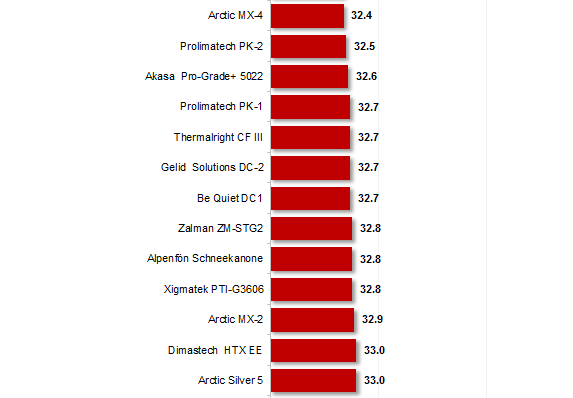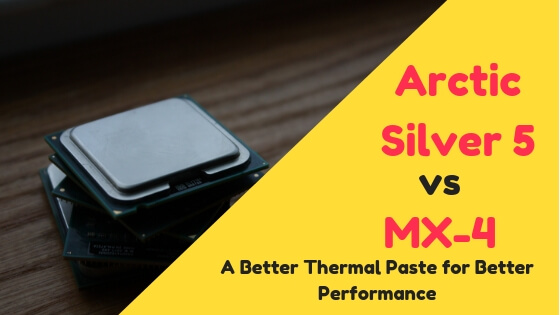A thermal paste is a thermally conductive chemical compound consisting of a polymerizable liquid matrix and a large volume of insulating filler loading (as high as 70-80% by mass) which is used as an interface between heat sources and heat sinks like high semiconductor devices.
Never underestimate the power of small details, or in this case, thermal pastes, it may seem unnecessary at first but you’ll be amazed how a few grams of paste can save your CPU’s life, when building a new PC you must consider choosing a really good thermal paste that helps with lowering the temperature of the CPU, there’re a lot of options out there but the best ones are going to cost you of course.
How does thermal paste work
Thermal paste is a material that is applied to an object, typically the base of a heat sink, to improve thermal conductivity between two surfaces.
Thermal conductivity is the rate at which heat moves across the surface of an object. It’s important because it determines how fast an object will cool down or warm up.
Electronic components can be sensitive to temperature fluctuations because they need to maintain a certain level of performance in order to function properly. Thermal paste fills in microscopic air gaps that would otherwise impede the ability of cooling fans or heatsinks to dissipate heat away from components, making them function more efficiently.
It can be hard to measure how much better one thermal paste is than another without testing them side-by-side in controlled conditions.
The role of thermal paste in computer processors is to provide a connection between the processor and cooler for transferring heat away from the processor. Thermal paste does not reduce temperatures by itself but instead provides a pathway for heat to escape from the processor as quickly as possible.
Today I’m going to compare two thermal pastes from the same manufacturer which is Arctic, the first one is Arctic Silver 5 versus Arctic MX-4.
Keep reading to discover the features of each paste and which one is better.
Arctic Silver 5


Features
- 99.9% Pure Silver for a better thermal transfer.
- Arctic claims that the Silver 5 will lower the temperature by 3 – 12 C over the standard ones, however, users have reported that it’s only 10 C.
- Non-electrically conductive.
- Easy to apply and remove.
Cons
Paste dries out
Check it out at AmazonArctic MX-4


A 2 awards winning thermal paste.
Pros
- Paste doesn’t dry out
- Better cooling by 2 C
- Suitable for overclocking
- Metal-free
- Lasts at least for 8 years
Features
- Easy to Apply for beginners.
- It does not contain any metallic particles so electrical conductivity will not be an issue.
Arctic Silver 5 vs MX-4
This chart shows the performance of different thermal pastes and it clearly shows that the Arctic MX-4 is slightly better than the Silver 5.

Source: https://www.tomshardware.com/reviews/thermal-paste-performance-benchmark,3616-17.html
The Arctic MX-4 compound is composed of carbon micro-particles whereas the Silver 5 compound is composed of 99.9% micronized silver.
The thermal conductivity of the Silver 5 is 8.9 W/mK whereas MX-4 is 8.5 W/mK.
Because the Arctic Silver 5 was released before MX-4 and gained more popularity over the years doesn’t mean it’s the best, most tech enthusiasts agree that the Arctic MX-4 is better than the Silver 5.
How to apply thermal paste properly
Some people, especially the beginners, apply thermal paste incorrectly by covering the whole surface of the CPU which is wrong, so the right way to do it is by putting a small drop or the size of a pea in the middle of the surface and gently put the heat sink above it and push it down until it spreads the paste over the surface of the CPU.
It’s also recommended to watch a tutorial on YouTube on how to do it properly, a video will explain it more so you can easily understand how the whole process goes so you don’t make any mistakes.
How long does PC thermal paste last
According to the experts, thermal paste typically lasts for between three and five years. However, this also depends on a lot of factors such as what operating system you’re running or how often you’re using your computer.
The lifespan of thermal paste depends on the environment. It lasts longer in the right conditions, but can wear out if it’s not used properly or if it’s put in an environment that has too much dust or debris.
The thermal paste should last for at least six months after it is applied to the CPU. After that, make sure to use a new batch of paste.
How to tell if thermal paste is bad?
You could spread some out on a sheet or surface that’s metallic to check whether it’s smooth and consistent.
if the thermal paste turns out to be watery, you should dispose of it away.
Most times, the thermal paste shouldn’t be replaced more than once every year unless the temperature of your CPU is rising really high.
To tell if the thermal paste in your computer is bad, you should look out for:
- Excessive temperature rise in the processor or graphics chip
- Computer turning off itself or throttling back to performance
- Dust clog in fans or heatsinks
Can You Reuse Thermal Paste?
However, the thermal paste can be reused by reseating the heat sink without applying new thermal paste.
It will still provide sufficient heat transfer to prevent damage. The problem with the paste is that it’s supposed to fill the gap created by microscopic valleys and pits once the heat sink and the CPU get in close contact with each other. It’s advisable to make sure the old thermal paste isn’t contaminated with dust, dirt, or any other thing that will prevent the heat sink and the CPU from sitting in contact with each other.
It can be reused many times by scraping off the excess thermal paste and applying it again, but after some time, the performance of thermal paste starts deteriorating.

I really wanted to value your article and your site in general but you open this article with an incorrect statement and in doing so have proven that you did not perform the necessary research before beginning this project.
Arctic Silver and Arctic are not the same company.
http://www.arcticsilver.com/
https://www.arctic.ac/
While the two companies may be different that does not invalidate any research on it. Arctic Silver split off a company just to serve the US market. This “might” be the reason they are different. In any case the comparisons are still valid and the products are still good. I tend to use Arctic MX-4 that I buy in 25 gram tubes because I use so much of the stuff. I have used all the different types and both of these are pretty good products. I lean towards the MX-4 over the AC silver which is an older product but in the end we are talking about two very good pastes with a maximum difference of about 2c so not any great amount.
You also don’t say if you did the required heating and cooling cycles for the breaking period which is required with Arctics Server which requires about 200 hours of use on average, but can take as much as 400 hours as detailed in the installation instructions http://www.arcticsilver.com/PDF/appmeth/amd/vl/amd_app_method_vl_1.3.pdf
And yes it does take that long to fully break in so realistically so you probably need about a month to complete as the CPU needs to cool for about 8 hours then be heated by normal usage.
In my case after about a month of use turning off my PC each night the using the computer as normal each day was required to allow the Arctic Silver to work at its best.
Douglas- if you have numbers, it would be instructive if you can give a comparison between the average temperatures you’re seeing now as opposed to when you first applied the compound- thx
The data are compromised in that you don’t disclose the ambient temperature for each datapoint during your study. System ambient temperature can greatly affect the temperature of a device…by multiple degC.
In addition, it’s unlikely the CPU temperature sensor readings are accurate/consistent to within even +/-0.5C just by themselves, so it makes no sense to record anything but the pre-decimal point numbers, and even that isn’t reliable.
In addition, very minor changes in the way a heatsink is mounted can result in considerably differing temperatures with the same system/heatsink/cpu/thermal compound. You can try to be as consistent as possible and you can still get temperatures that vary by multiple degrees C in the “same” circumstances.
In addition, if the CPU fan is being controlled by an “auto” setting then again, the maximum CPU temp reading can vary considerably because the fan rpm algorithm can also create significant rpm differences in the fan based on background processess loading in the system…and Windows background processes are NOT predictable and generally not controllable unless you keep them all from loading so the temperature will change due to those differences..
There are too many variables that are not controlled in a computer system that the temperature at a given point can be considered reliable to within several degrees, never mind a fractional degree. Even if you get what appear to be consistent results, it doesn’t mean they are accurate results.
If one is testing the just a thermal compound, then you have to eliminate multiple variables. The only practical way this can be achieved to a meaningful degree in which thermal compound comparisons can produce meaningful results is by eliminating the computer/CPU completely, and using well controlled energy sources, precision methods and physical interfaces, and more accurate temp sensors, suitable insulation, and an environmentally controlled chamber.
“The thermal conductivity of the Silver 5 is 8.9 W/mK whereas MX-4 is 8.5 W/mK.”
The technical specs of AS5 are better so it seems weird that AM4 cools 2 degrees more.
This is how you do not prove anything.
There is so much wrong that I just assume you do not know the proper procedure when comparing products based on results.
Also, the results lie in the accepted variables, I assume.
Do the right thing, and call out these lies they try to sell us(the producers)
In contrast to metal and silicon thermal compound, the MX-4 does not compromise over time. Once applied, you do not need to apply it again as it will last at least for 8 years.